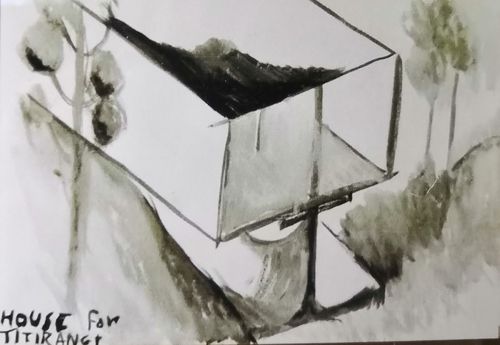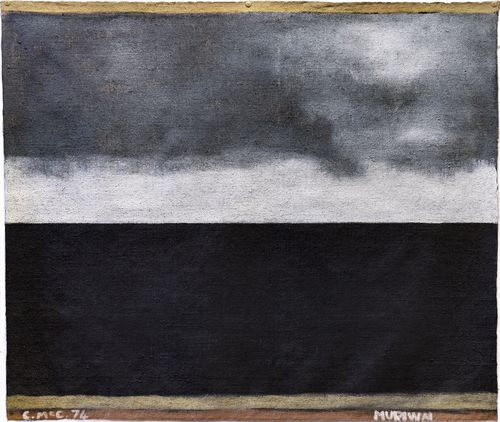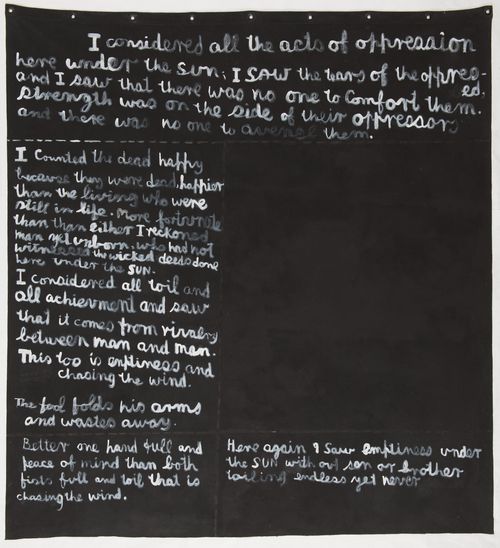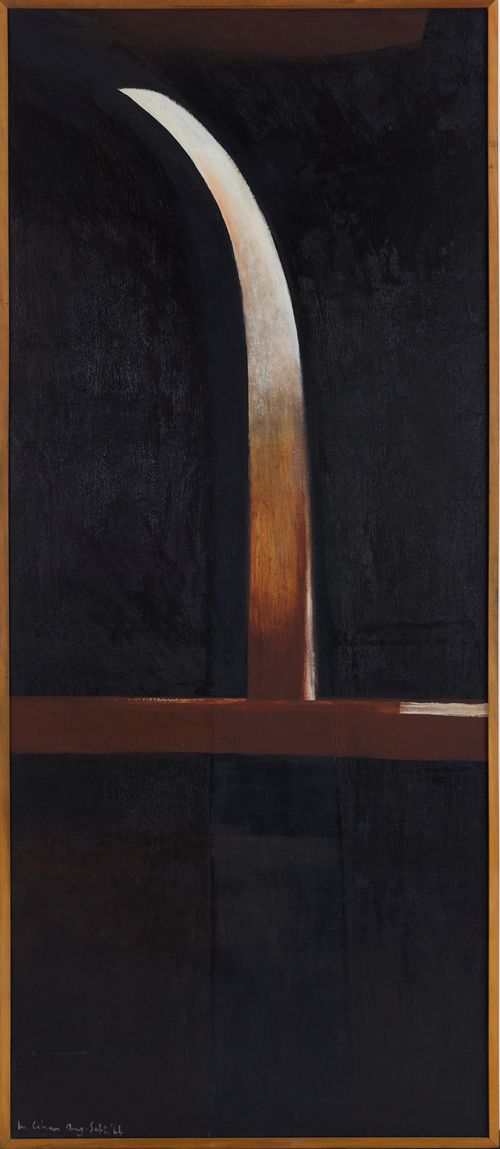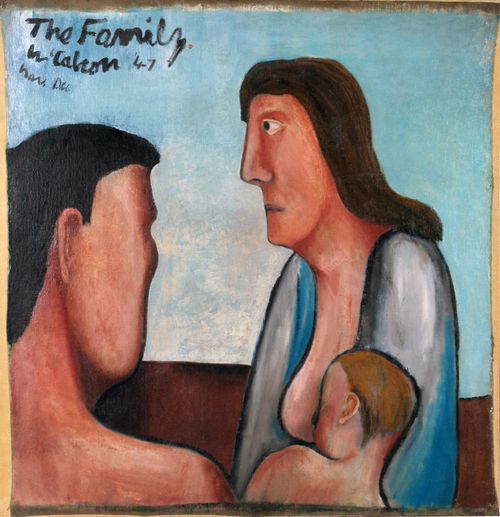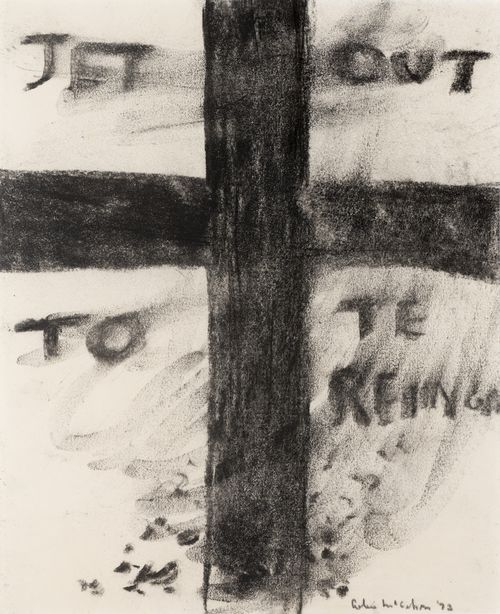Ka pōraruraru ahau. I am troubled.
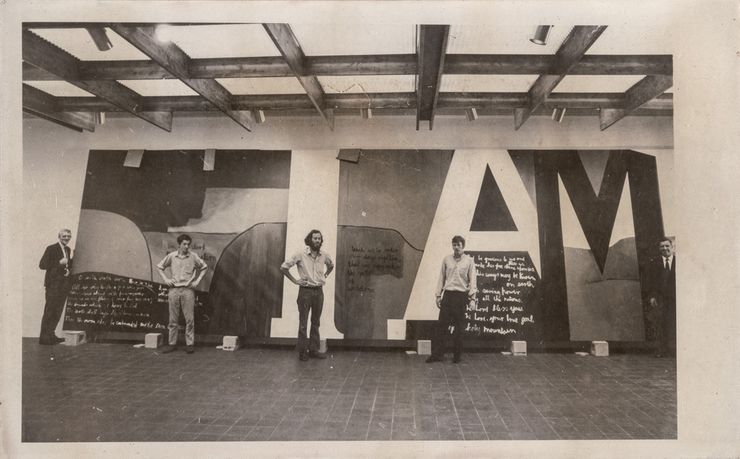
Installation of Colin McCahon's Gate III, 1970, Ten Big Paintings Exhibition, Auckland City Art Gallery, 1971

Shannon Te Ao, Untitled (McCahon House Studies), 2012, single channel video with colour and sound, 4:34min. Cinematography: Iain Frengley
Shannon Te Ao
Remembered as New Zealand’s foremost painter, McCahon is arguably our most celebrated artist. His body of work has become inseparable from grand narratives of New Zealand Art. His work is attributed with commencing our own artistic modernity, and
plots a visual arc that is often positioned as a counterpoint to our contemporary bi-cultural era. Images of his works endure, far beyond the context of their making and now more than thirty years after his passing.
I have been intrigued rather than captured by McCahon’s iconic status here in Aotearoa. While at art school in the early 2000s I found him a bemusing cultural figure and artist. McCahon’s Gate III (1970) and Victory over death 2 (1970), two of the well-known
‘I AM’ works, were completely audacious to me. Bold and fragmented at the same time. His work, as I saw it, presented a disarmingly transparent insight into his very personal, evolving relationship to Aotearoa. Pastoral landscape, religious motifs, spiritual refrains,
along with excursions around te ao and te reo Māori are all pitched within his oeuvre as existential devices.
Nonetheless, I feel that McCahon’s vision—his place in culture—was never fully reconciled. In light of this, his work evokes a lot of tension. Angst is literally the subject matter in so many of his paintings and perhaps not surprisingly, was a constant within his life. As the title to his 1976 work goes—Am I scared? On manifold levels his work conveys dissonance and uncertainty. Despite this turbulence, McCahon’s cultural position appears steadfast. I have always wondered what this actually says about us?
My first visits to the McCahon family’s former home in Titirangi were revelatory. By today’s standards the McCahon House Museum in French Bay resembles a weekend bach. On a bright summer’s day, nestled within the backdrop of the West Auckland bush setting, with many of McCahon’s DIY improvements still visible, the place exudes a palpable charm. It’s easy enough to romanticise about the period the McCahon family spent here. For a different perspective, I recommend you also visit on a rainy day in July. When the elements turn against the architecture, it’s impossible not to imagine how tough a setting this would have been for Colin, Anne, and their four children. This toughness undoubtedly
fuelled the struggles and alienation that are well documented within McCahon biographies
I felt so conflicted about the history of McCahon House I was compelled to make my own artwork on site, in order to disrupt the iconic myth of McCahon. In the summer of 2011, I created an ambiguous persona in response not just to McCahon but his family who lived at the house with him. I made a short video, looking like a household shaman, and
performed a series of actions or mutated domestic duties as if blindly navigating the space. The work is not intended to be funny—and is perhaps more uncomfortable than humourous.
In 2017 I was invited to present Untitled (McCahon House Studies) alongside a survey of
McCahon’s work. Colin McCahon: On Going Out with the Tide curated by Wystan Curnow and Robert Leonard at City Gallery Wellington, presented for the first time an overview of McCahon’s work in response to Māori subject matter. Nowhere else is McCahon’s artistic and cultural dissonance more explicit. The experience sparked a real-time assessment of my relationship to his work. This body of work stretching across the 1960s and 70s is unceasingly—and appropriately—criticised for its naivety and problematic integration of te reo Māori and whakapapa. Even the ‘simplest’ works within the exhibition present a tenuous position. Works such as Koru 1, 2, 3 (1965) and Caltex 1 (1965) reference crude koru-like forms, but ultimately alienate a Māori audience.
Described by the curators as ‘piecemeal and partial’, McCahon’s lack of understanding and sensitivity is telling. Other works presented in On Going Out with the Tide engaged histories and whakapapa with a freedom that was not McCahon’s to wield. I’ve had people tied to some of these histories point out errors and a usage that belittles the tūpuna named throughout these works. What was once excusable in light of good intentions and the avant-garde ethos is now culturally and politically incorrect. It is no longer acceptable to legitmise appropriation, mis-use, or mis-representation. One has to ask the question … What narrative does McCahon’s legacy truly serve? In 2019, I struggle to see how the implications of his work can truly embrace all that Aotearoa has become.
This is not intended as defamation. I’m not trying to sully McCahon’s memory. His commitment to his own practice can’t be faulted. And I respect his ambition. But I think we should let McCahon off the hook. His work maintains a position and cultural outlook that no longer serves the true fabric of discourse here in contemporary Aotearoa. McCahon is only our most celebrated artist because those with the power and privilege continue to attribute this honour to him. This in itself is not an inherently problematic gesture. But the default referral to McCahon underlines the need for more appropriate,
contemporary, and diverse cultural representation
It should not be lost that alongside McCahon100 events, a number of exhibitions currently on view in Wellington highlight works by McCahon’s contemporaries. Gordon Walters and Theo Schoon are both represented within major surveys at Te Papa and City Gallery Wellington. Unsurprisingly, I’ve heard numerous criticisms from peers in response to the timing of these exhibitions and what they might say about artistic values—or our valued artists. As a current snapshot of the local art scene, one could be forgiven for accusing us of obsessing about the McCahon era as some kind of ‘Ol’ Boys Club’ and narratives that privilege settler experience. The timing of these exhibitions paints a picture that reveals
an apparent collective complacency; a reticence to disrupt and overturn longstanding narratives that marginalise all but the Pākehā position. To me, this dissonance feels palpable.
The maintenance of a dominant, male, Pākehā narrative no longer satisfies any inclusive
representation of our collective consciousness or being. If you are like me, this will not be news to you. In the same month that we celebrated the legacy of McCahon, here in Te Whanganui-a-Tara, we’ve also seen exhibitions that counter this narrative. A major
survey exhibition by Joyce Campbell, and a solo exhibition by Ayesha Green—two formidable projects which do just that but have not been afforded even
a blip of attention in comparison.
Both of these exhibitions embody real currency, bringing a raft of issues born from our colonial imprint. Environmentalisms, feminisms and our bicultural register are treated within these projects with an intelligence and sensitivity that are responsible to our present, not just our past. The same could be said of HERE: from Kupe to Cook currently showing at Pātaka Museum in Porirua. All three projects confront the social schema with a healthy criticality and a sophistication befitting the complexities of our time. One has to wonder what might be different if exhibitions like these were at the forefront of our thinking? What would public opinion look like in a context that accepted artistic contributions like these as testament to our culture with the same fervour that we maintain an artistic canon that we have arguably outgrown? What’s stopping us from painting a more current picture of ourselves?
'Ka pōraruraru ahau. I am troubled.', is a slightly edited version of Te Ao's ’The problematic legacy of Colin McCahon', first published on The Spinoff Art, 21st September 2019.
The problematic legacy of Colin McCahon (21/09/19)
Purchase a print publication of McCahon 100 here.
